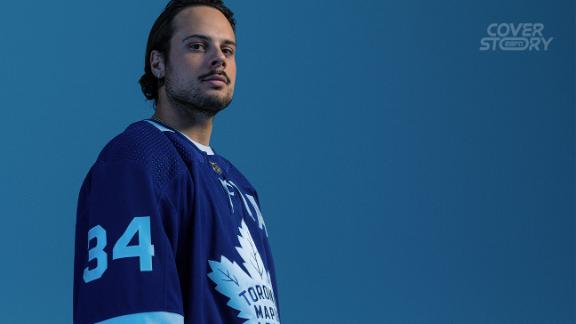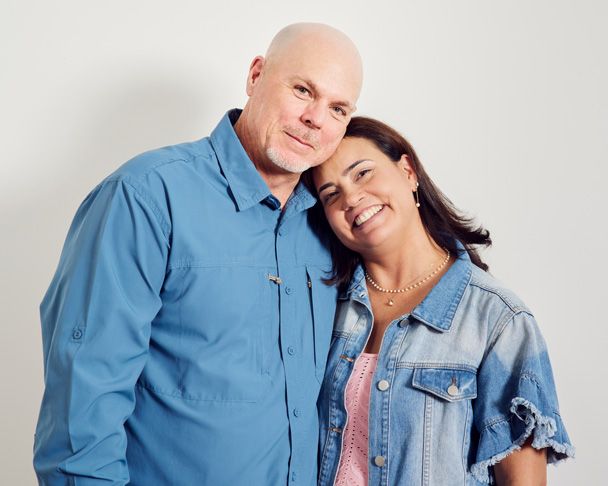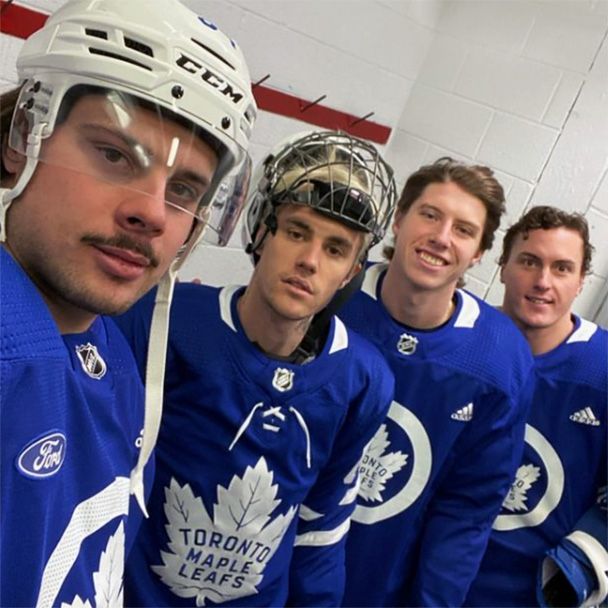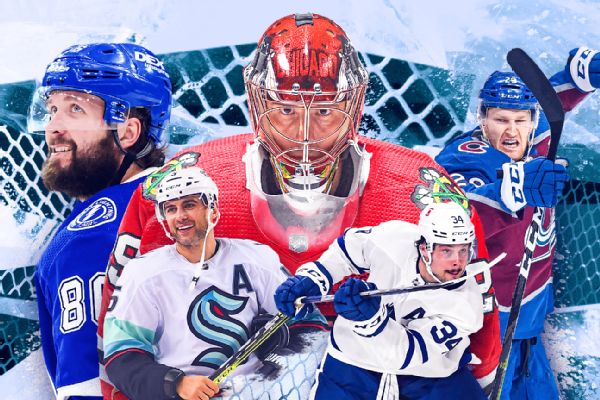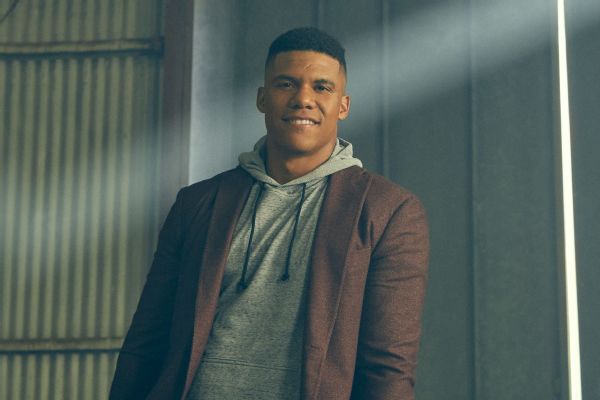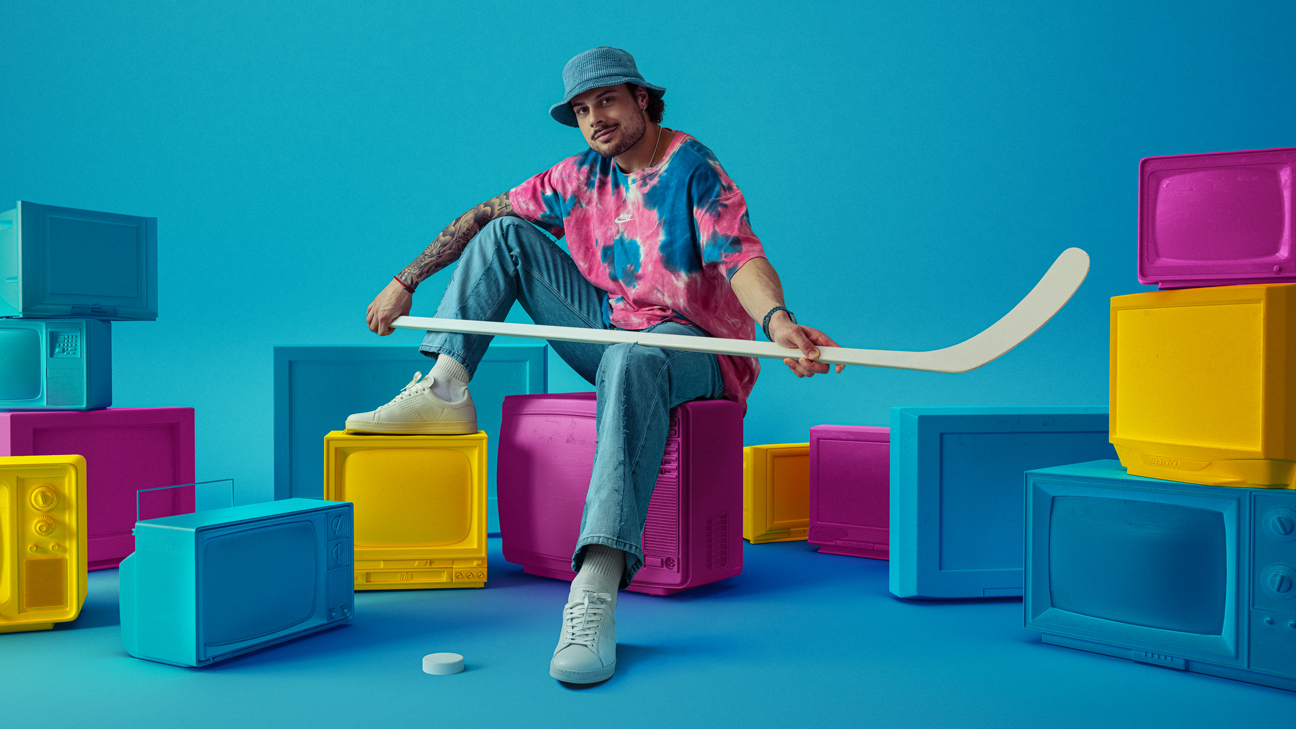
All eyes on Auston Matthews
The Maple Leafs center is far from a traditional NHL superstar -- but he might be exactly the kind of star it needs.
It's a Wednesday in August, at the height of hockey's cottage season -- when the NHL's general managers are sprawled across lake-adjacent homes, mostly in Canada, Minnesota or Massachusetts, and league business enters snooze mode. Auston Matthews is at his offseason base too, but his is a 7,500-square-foot home at the foot of Camelback Mountain in Arizona. One of ice hockey's brightest stars finds his sanctuary amid cactuses and tumbleweeds. And right now, it's anything but a snoozefest -- Matthews' home is bustling with activity. His best friend, former teammate Frederik Andersen, is lounging on the couch. His functional doctor -- "Dr. Steph" -- has flown in from Toronto and is setting up a treatment table in the living room. A few feet away in the kitchen, his personal chef -- "Chef Chris" -- is unloading jugs of mineral water from Whole Foods bags into the fridge. His agent and his agent's assistant are scurrying from room to room, popping in and out of Zoom calls, and his mom, Ema, and dad, Brian, have popped by to say hi; they live just 20 minutes away. Matthews' Aussie Bernedoodle, Felix, is buzzing around them all. Matthews, in the center of it all, is glued to his TV. It's tuned to the early rounds of the US Open tennis tournament -- which "would be sick" to attend one day, he says. Tennis is Matthews' latest obsession. "If he's into something, he goes in 100%, more so than I've ever seen in anyone," Andersen says. "If he wants to get good at golf, that's all he talks about. And right now he can't golf or skate because of his wrist, so it's tennis. Tennis everywhere. We're hitting balls all the time. He's watching it, thinking about it. He's on deep internet dives and asking all the questions to know how he can be the best at it." Maple Leafs center Auston Matthews tells Emily Kaplan about his upbringing and how it shaped him into becoming a star on the ice. Produced by Barry Abrams, Mike Farrell; edited by Scott O'Leary, Nathaniel Ayoub, Kristina Daley. The cause of Matthews' new dependence on tennis -- with a one-handed grip -- is one that had sent shockwaves through the hockey ecosystem eight days earlier. The Maple Leafs issued a short news release announcing that Matthews underwent wrist surgery. It was really not a big deal -- an overdue fix to a longstanding issue that flared up in offseason training. Matthews is sitting out a few games to start the season, but he plans to be at full strength in no time. But when you're the star center of an Original Six franchise at the forefront of the buttoned-up hockey universe, even not a big deal is still a big deal. "Why didn't the Leafs get Matthews to have surgery earlier?" a headline on TSN asked. "Why Are the Maple Leafs So Quiet about Auston Matthews' Wrist Injury?" the blog NHLTradeTalk mused, citing the scarce info available, such as whether it was his left wrist or his right one. It's excessive scrutiny. It's also what Matthews has become accustomed to -- whether he likes it or not. In his everyday life, Matthews values privacy, which is why he really savors these few months of quiet in Arizona. It's here, where his origin story began, that he can remain the most anonymous. "Coming back and just going to the grocery store and just being a normal citizen," he says. "Nobody really bothers me, or talks to me or recognizes me. It's kind of nice." That's not the case in Toronto, or at any league event, where Matthews is "the NHL celebrity," as his good friend Zach Werenski of the Columbus Blue Jackets puts it. It's true that Matthews seems to be, finally, what the NHL has craved for so long: A player who can turn hockey stardom into something transcendent. Matthews, 24, has the talent to fit the billing. As a center, Matthews plays a complete two-way game, but it's his lethal shot -- really, his arsenal of shots -- that makes him special. "It's powerful and determined," says Andersen, who spent the past five years as Toronto's starting goalie and faced Matthews at practice every day. "I know those are weird words to describe a shot, but the way he comes down, he's very quick and forceful in where he picks his spot, and he's good at disguising it, too." Matthews ran away with the NHL goal scoring crown last year, despite the bum wrist that often prevented him from properly gripping his stick. Since he entered the league in 2016, only Alex Ovechkin has scored more goals -- though Matthews has 21 more at even strength. But even as Matthews' fame grows, it's hard to know how transcendent he can be in the sport he plays. The NHL is predicated on all things team. In hockey culture, the only voices that matter are those that come from the locker room, and those voices typically don't even use the pronoun "I" -- players are accustomed to saying "we" or heaping praise on a teammate instead. It's not uncommon for a player to turn down an endorsement deal, afraid of how it will be perceived. Matthews was drafted in 2016 by Hall of Fame GM Lou Lamoriello, who famously believed the face of the franchise should be, and always has been, a royal blue image of a leaf. Under Lamoriello's reign, rookies were not allowed to do in-game interviews. And so Matthews -- the No. 1 pick, who scored four goals in his first game, and went on to post the best rookie season in the 100-year history of the franchise -- never did an in-game interview. The franchise's rules, combined with the sport's expectations, meant Matthews never really put himself out there. Now, going into his sixth season in the league, Matthews feels ready to change that. "As the years have gone, I've just kind of grown into myself a little bit more," he says. "And maybe felt more comfortable just being myself and not really worrying about what everybody else thinks or says." That means leaning into fashion, posing for video game covers, innovating with equipment and embracing endorsement deals that earlier stars in his position might not have. It also means that Matthews has achieved a level of celebrity that few players in the sport ever have -- and he just turned 24. A year before his three-year entry-level deal expired, Matthews' agent, Judd Moldaver, began contract negotiations with Kyle Dubas, the 30-something whiz kid who replaced Lamoriello as general manager in 2018. They called a meeting at Maple Leafs headquarters. Moldaver knew the Leafs' front-office representatives would outnumber him, so he asked his colleague Jeff Jackson, who represents the league's top player, Connor McDavid, to come with him for moral support. The Maple Leafs began their presentation by going through some comparables. Moldaver interrupted the conversation. "Auston doesn't have comparables," Moldaver said. "Don't you understand? He's a unicorn." Since Matthews entered the league in 2016, only Alex Ovechkin has scored more goals -- and Matthews tops even him by double digits at even strength. Marcus Eriksson for ESPN IT'S NOT JUST Matthews' goal scoring or his personality that puts him in his own class. His origin story had set him apart from a typical NHL player well before he arrived in the league. Matthews' father, Brian, is from California. His mother, Ema, was raised on a ranch just outside of Hermosillo, Mexico. "Growing up in Mexico, it was very simple," Ema says. "Being on the ranch, in that world, it's amazing. It's seeing natural animals, quiet, no traffic, just you and the beautiful green in the desert. It's another world. You grew up very humble because you see how privileged people are." Ema's father, Rafael, spent his days tending to the cattle and horses. Her mother, Alicia, took care of Ema and her seven siblings. Having the ranch, Ema says, was a privilege many around them didn't have. The family lived comfortably; although water often had to be lugged from the well to the home and there was no electricity, the children all went to school and were told to pursue their dreams. Ema wanted to become a pilot. But pilot training was expensive. And, as Ema admits, "as a woman back then, it was different." She became a flight attendant. Ema began working flights for Aero California, with regular routes to Los Angeles. That's where she met Brian Matthews, who was working part time for an airline to help pay for college; he was a baseball player at Loyola Marymount. It was love at first flight. "My parents spent my whole childhood doing everything for us and they were never really doing anything for themselves," Matthews says of Ema and Brian. Jesse Rieser for ESPN Ema moved to California with Brian. He became fluent in Spanish, and she perfected her English. As they began a family in America -- Auston, born in 1997, was the second of three children -- it was important for them to incorporate Mexican culture. Brian wanted to speak purely Spanish in the house so the kids would grow up fluent in both languages. "Happy Birthday" was always followed by "Feliz Cumpleaños." Auston was called "Papi," a traditional Mexican pet name. Growing up in Scottsdale, where the family moved a few months after Matthews was born, to a Mexican American family might not have seemed like a prime ground for hockey fandom -- except that commissioner Gary Bettman's beloved Sun Belt expansion plan had just given birth to the Arizona Coyotes, who opened play in Phoenix the year before Matthews was born. Matthews began going to Coyotes games at age 2, tagging along with his uncle, Billy, a season-ticket holder. By 6, Matthews asked for his first pair of skates. Soon, he was gobbling up as much competition as he could find. Everyone around the rink knew him as Papi, to the point that some kids didn't know who "Auston" was. On weekends, Papi would sit in the locker room of the local rink, Ozzie Ice, armed with a rainbow of jerseys, hoping a visiting team needed a fill-in player. Ozzie Ice had only two sheets of ice: one was a half-sheet; the other was synthetic. The tight space allowed Matthews to master his stickhandling, to figure out how to rip a shot from the smallest of windows or unexpected angles. Matthews grew up playing baseball too, but he always found hockey more exciting. It helps that at age 8, he was at Glendale Arena when Ovechkin scored The Goal -- the improbable rolling-over-on-his-back showstopper that still plays on highlight loops. "I still get chills thinking about it," Matthews says. There wasn't enough action in the desert, so the Matthews family was constantly shuttling to Michigan or Canada for tournaments. At 12, Matthews moonlighted for a Ukrainian team at a pee wee tournament in Quebec. (He met one of the coaches not-quite-halfway in New Jersey for the tryout). Such extremes became expensive, even for a two-income family. Brian worked in technology, and Ema was a waitress at a high-end restaurant. To cover costs -- sometimes clearing $20,000 a season -- Ema picked up a second job at Starbucks. Matthews gets emotional when talking about that time. As his eyes well up with tears, Felix scurries to his feet to comfort him. "My parents spent my whole childhood doing everything for us and they were never really doing anything for themselves," he says. Matthews explains how he was scouted at a tournament and invited to try out for -- then made -- the U.S. National Team Development Program and moved away to Michigan. Back in Arizona, his mom kept her two jobs. After long shifts, she would take her tips and deposit $20 into her son's debit account, he says, "just so I could get Chipotle with the boys." And when Matthews' journey took him even farther than Michigan, his parents remained steadfast in their support. There are two traditional paths to the NHL: playing junior hockey or playing in college. Since Matthews was literally off the radar in Arizona, recruiters were late to the game. And because his skill set was so unique, his agents devised an unorthodox plan. At age 17, Matthews signed a professional contract in Switzerland. “The way he comes down in his shot, he’s very quick and forceful in where he picks his spot, and he’s good at disguising it, too.” Ema followed and lived with her son in Switzerland, where he scored 46 points in 36 games playing against grown men in the National League A. Now he was the best hockey prospect on the planet. After the Maple Leafs drafted him at No. 1 in 2016, Brian shacked up with his son in Toronto during his rookie season. Fans began recognizing Matthews before his first game. After he scored four goals in his debut game, it was pandemonium. It's been a tough balance to find for Matthews, whose personality vacillates between ostentatious and private. Andersen jokes the pandemic actually treated Matthews well because he could wear a mask everywhere and hide. However, wearing a mask and blending in is a paradox for Matthews. "It goes against his personality," Andersen says. "He loves to dress up, look sharp and maybe even look a little different -- his sense of style is sometimes about trying to stand out. But obviously that makes him easier to pick out in a crowd or on the street. And a lot of times in Toronto he doesn't want that." Or if he does -- he wants it on his terms. He's frustrated sometimes by the traditionalism of hockey, where moments of self-expression can be hard to come by. His fashion curiosity was piqued when he played in Switzerland. "Obviously the guys there have really good style," he says. "And I had the funds to back it up. So I bought some probably ridiculous stuff" -- he winces thinking about his skinny jeans suffocating his thick hockey quads -- "but I thought it looked good at the time. Looking back, it was like 'yeah, that's not it, probably.'" So it's frustrating to Matthews, a 24-year-old who can't count the number of sneakers he owns, that the CBA stipulates that on game days, players must wear a suit and tie unless otherwise specified by the team. Coincidentally, the only team that has relaxed its dress code is ... Matthews' hometown Coyotes. Matthews wants more teams to follow. "I don't mind wearing a suit, but it gets old pretty quick," Matthews says. "I think it'd be fun to wear different things and be able to express yourself, similar to what the NBA does or even the NFL a little bit." "As the years have gone, I've just kind of grown into myself a little bit more," Matthews says. "And maybe felt more comfortable just being myself." Marcus Eriksson for ESPN GOING FROM ARIZONA to Toronto, a city with hockey bona fides and huge expectations, was a shock to the system for Matthews. He arrived already facing enormous pressure to help turn around the Maple Leafs -- one of the NHL's original franchises, winners of 13 Stanley Cup finals -- and a team that hasn't won the Cup since 1967. The Leafs haven't even been back to the Finals since then. When Matthews was drafted, the Leafs had made the playoffs just once in the previous 11 seasons. Since his second year in the league, they've finished no worse than third in their conference (they finished first in 2020-21, for the first time since 1999-2000) -- and yet, no matter how much regular-season success they achieve, they can't get past the first round. Toronto is the only team in the league that has three forwards (Matthews, Mitch Marner and John Tavares) making at least $10 million. A fourth forward, 25-year-old William Nylander, is making a shade under $7 million. Yet each year, the Maple Leafs are the NHL's soap opera. Expectations have built over each of Matthews' four seasons, and each year the team finds a new way to blow it. The situation is both increasingly dramatic and inevitable. Adding salt for 2021: The season was documented by Amazon production crews for the series "All or Nothing." "The best example to describe it would be somebody who played for the Red Sox from 1999 to 2003," Dubas says. "Our team is very talented. We have not been able to achieve the goal that we've aspired to in the playoffs or have playoff success yet. The public and the media, when things don't go well, look to the best players for them to propel the team there." As the Stanley Cup drought continues -- now at 54 years -- the current players are reckoning how to handle notoriety that they are not responsible for but are now a part of. For Matthews' part, he can declare more personal accountability, as he did at last year's exit meeting with Dubas, and spend every offseason improving his skating, which is already quite strong. He can be the best player he can be and best teammate he can be -- but he still might not be able to remedy his team's streak of eight straight losses in series-clinching games. He takes the losses personally, especially last year. The Leafs were the kings of the North Division all season. Their first-round opponent was the hapless Canadiens, who finished 18 points behind in the standings. This was supposed to be a cakewalk. When the Canadian network Sportsnet polled its 23 hockey personalities as to who would win the series, all 23 picked Toronto. The Leafs even had a 3-1 series lead. And then their offense dried up at the worst time and the Canadiens won the final three games of the series, twice in overtime. Losing in the first round, yet again, was humiliating. According to his parents, Matthews was despondent for weeks. "We know him and we know how he is, and he wasn't the same," Brian Matthews says. "The conversations we were having were different, like just non-belief, disbelief, questioning things." Matthews has faith in the group. He wants to bring a Stanley Cup to Toronto more than anything, and he knows it's within reach. No matter how unconventional Matthews can be, he also spews the team-first hockey clichés out like the best of them -- and he actually believes them, too. At the end of last season, he somehow crammed the phrases "get the job done," "what great teams do," "failed to execute" and "you've got to make your own luck" into one soundbite. The one thing hockey culture values over everything is a Stanley Cup; a team championship is the ultimate currency. For Matthews to gain full acceptance in his sport, to be given the freedom to unlock the next level of stardom, the Maple Leafs need to win. LIVING IN TORONTO has taught Matthews how to avoid unneeded attention -- he swears he hasn't searched his name online in years (he missed the drama about his wrist injury online altogether). Sure, he is scrolling Instagram constantly -- he is part of Gen Z, after all -- but he infrequently posts himself. "I don't care if you're somebody that likes to go, 'this is what I'm eating for breakfast and this is what I'm doing after breakfast. Then after lunch I'm going to go do this, and this is me doing this.' I don't mind. That's all good," Matthews says. "I just like to keep to myself for the most part. I like to share stuff when I feel like it, but it's honestly just how I'm feeling at that particular time." Matthews listens to those closest in his life, and he tries to block out the rest. Even if he's not seeking it out, that outside noise always seems to penetrate through. Matthews understands the frustration from Toronto fans, but he doesn't understand the constant negativity. "Sometimes I feel like everybody's like a coach or like a scout, and so they're just very critical about stuff," he says. "I know they grew up playing hockey and I know that they love hockey and they watch a lot of hockey and stuff, but I don't know, I find sometimes they can just be very... They're just very passionate, so I think that just brings out that kind of side of them. They obviously want us to succeed and as do we, but I think sometimes maybe the passion blinds their brain to think normally." That's what Matthews thought when one fan, during a home game against San Jose in 2019, caught his attention. He wore a white knit hat, carried a cup of beer and was loud. "Dude," Matthews asked teammate Tyler Ennis. "Is Justin Bieber behind us?" "Yeah," Ennis said. "I thought the same thing." As Matthews skated to the bench at the next whistle, he made eye contact with the pop star. "Yo," Bieber said. "What's up?" Matthews met Justin Bieber when the pop star was banging on the glass at a Maple Leafs game -- now they talk, text and even vacation together. justinbieber/Instagram According to Matthews, Bieber spent the rest of the game pumping him up, then slid into his DMs that night. They messaged as the Leafs were whisked away on the team charter. "I was sitting next to Tyson Barrie, and we were both tweaking out," Matthews says. "Like, 'No way, this is so cool.'" Within two months, Matthews was invited to play shinny hockey with Bieber's childhood buddies in the outskirts of Toronto. (Matthews' scouting report: "He's the second-best player I've seen besides Vladimir Putin.") Matthews invited Bieber to a private box to watch a game with his family; Bieber extended his hospitality by including Matthews and friends as part of his entourage for a UFC fight in Vegas. During the pandemic, they vacationed together on a tropical island and co-starred in Instagram live sessions. Bieber's wife, Hailey, has a theory about why they click: The two men wish they had each other's lives sometimes. But Bieber is a hard-core Leafs fan, meaning Matthews had to establish some boundaries. "When we first started talking and becoming friends and stuff, [Bieber] texted me like, 'We need a D-man. We need a guy like Brian McCabe,'" Matthews says. "I just laughed so hard because it's like, you're no different than the guy on the street that's coming up to me being like, 'Hey, nice to meet you. Can I get a picture? Man, we need a guy ... We need this, we need that.'" But Matthews puts up with it because he looks up to his friend. People thought Bieber might have been a one-hit wonder or gotten lucky at the right time, Matthews explains, but he's constantly evolving. Bieber is always curious too. During the pandemic, Matthews became obsessed with chess -- in the same way he fixated on tennis. When he brought it up to Bieber, it turns out the pop star had picked up chess years earlier and happened to be really good at it. But Matthews has also learned about navigating fame, about the importance of having a support system. "I didn't know him back in the day when he was a little bit younger and a little bit wilder, but now you just see he's very family-oriented and he spends lots of time with his cousins, his dad, his mom," Matthews says. "He's very much involved in all of their lives and takes time out of his day to call them and make sure that they know he's thinking about them and stuff like that. I think that was just, for me, really cool to see because I try to be that way as well, but I think you can always get lost in that. Your life gets busy, but you can't forget about your family and the people that you truly care about." From Arizona to Michigan to Switzerland to Toronto, Matthews has taken an unconventional path to NHL fame, but he has ended up as one of the league's most decorated stars anyway. Marcus Eriksson for ESPN MATTHEWS LIKES TO change something every offseason. In 2020, he started working with Chicago-based trainer Ian Mack, who trades lifting weights for body-movement-based pliability. He's now a lean 6-foot-3, 220 pounds. This summer, he really leaned into his work with Dr. Steph, whose full name is Stephanie Canestraro, the CEO and founder of the Vagus Clinic. Matthews asked her to revamp his entire house with clean products; he wanted no toxins in his laundry detergent or body wash. Canestraro, whose specialty is the connection between the brain and the gut, has more than two dozen clients in the NHL. She counts Matthews as her star pupil. "He always wants to be on the cutting edge of whatever comes up next," she says. "I call a lot of guys and they're like, 'I fell off for two weeks,' or for a lot of guys, if their wife doesn't feed it to them, they're just not taking it. Auston is the one ordering the next bottle on his own." He's confident in his interests but also endlessly curious about new ones. He was one of the first NHL players to launch an NFT. Unlike most hockey players, who are precious about their equipment -- there are guys in the league using jock straps from before Matthews was born -- Matthew asks why things have to be done the way they've always been done. One of his NHL role models is Ovechkin, ever since 8-year-old Matthews witnessed that goal -- but not just for what he does on the ice. "He'd do awesome celebrations and stuff, and I remember Don Cherry would rip him apart," Matthews says. "And then he did an interview with, actually, I think it was with ESPN, and he was talking about how they just want you to be a robot -- 'I score a goal, I go back to bench, blah, blah, blah.' But he didn't care. He was like, 'I'm just being me. I'm having fun. I'm playing in the NHL; this should be fun.'" “It’s pretty crazy, but it’s awesome for the sport -- to have a guy like that, the fashion, the GQ, the friendship with Bieber? It only grows the game.” That's what Matthews has tried to bring to his own game. This year, inspired by the NBA's sneaker game, he commissioned his equipment partner, CCM, to make a handful of custom skates and sticks that he plans to debut for games. It will be like walking into his closet and picking out a pair of sneakers, whatever he's feeling that day. (Matthews' team showed me previews of the custom skates. They're flashy. The hockey traditionalists will have opinions.) They're also brand-new models, another thing hockey players are particular about. Consider Matthews' teammate, grizzled 38-year-old veteran Jason Spezza. "He's the kind of guy that likes what he likes; he'll stay with a model as long as he can," Matthews says. "But in talking to him, he's like, 'I wish I would have adjusted as the years went by. I wish I would have adjusted to construction, or just tried different things. Maybe I would have liked it.'" Matthews isn't ready to take on a century of hockey tradition single-handedly. So for now, he'll find ways to show his personality in ways that will disrupt but not overthrow: the photo ops, the skates, the style. In July, Matthews went with his sister, a master of Yelp, to a piercing place she recommended to get his ears pierced. "I actually wanted to get them pierced when I was younger, because I used to skateboard and I was into, like, Tony Hawk and Ryan Sheckler, and [Sheckler] had these big diamond ear studs," he explains. "I asked my mom to get my ears pierced and she said OK, but I never did. Maybe because I was too scared. So I don't know, I said why not now? If I don't like it, I can always take them out." It was another item that set hockey internet aflame. The earrings debuted during a long weekend in New York (incidentally, the same weekend Matthews had the surgery on his left wrist). Matthews and his agent went to a wax museum, where he posed for a photo with faux Ed Sheeran (who everyone thinks is a doppelganger for Andersen), then sat front row at the Mets-Dodgers game. By the time the internet caught a glimpse of Matthews on the broadcast, all they wanted to talk about were his new pierced ears. This is a boon for hockey -- a young, personable star, one who wants to appear on national broadcasts, who isn't afraid to test the boundaries and make a splash. Matthews can be transcendent for the sport -- if it lets him. "I was in Vegas with him for that McGregor fight when he was walking around with Bieber that whole weekend -- and that's crazy in itself that that's one of his best friends," says Werenski, Matthews' friend who plays for the Blue Jackets. "But just the people that come up to him, it's constant. Next to him are all these music artists, and Kendall Jenner, but people are coming up to him and recognizing him. It's pretty crazy, but it's awesome for the sport -- to have a guy like that, the fashion, the GQ, the friendship with Bieber? It only grows the game." Production by Sean Frith/Field Trip Production; prop styling by Jo Jin; grooming by Britney Sinclair/P1M; wardrobe styling by Nadia Pizzimenti/P1M; Look 1: T-shirt by Nike @ Nordstrom; pants by Marni @ Hudson's Bay; hat by Obey @ Hudson's Bay; shoes by Tom Ford @ Harry Rosen; Look 2: jacket by Wooyoungmi @ Hudson's Bay; hat by Balenciaga @ Nordstrom; pants by Paul Smith @ Hudson's Bay; shoes by Givenchy @ Nordstrom; T-shirt by Tom Ford @ Harry Rosen; Look 3: sweatshirt by Stone Island; pants by Missoni x Palm Angels @ Nordstrom; shoes by Alexander McQueen @ Nordstrom.